All Categories
Featured
Table of Contents
Glass & Glazing - Easy Windows Upvc Double & Triple ... in Marangaroo Perth
Laminated glass is typically utilized in locations in the home most susceptible to injury from human effect such as bathrooms, doors, around staircases and in locations near to the flooring (it meets the requirements of 'security glass' that is mandated for use in these locations by Australian Basic AS 1288 Glass in structures).
Toughened glass has actually been 'tempered' by being reheated and quickly cooled again. This process makes it much stronger than standard glass it can withstand higher effect loads prior to breaking. It likewise makes it more secure since, when it does shatter, it gets into numerous small cubic pieces rather than harmful shards.
Double Glazed Windows – Their Amazing Benefits For ... in Hillman Perth
Toughened glass has no thermal or acoustic advantages over other glass of the same toning or density. Secondary glazing is where single-glazed windows are retrofitted with a transparent acrylic or glass sheet connected to the inside of the frame or openable sash with a secondary frame or with magnetic strips.


Secondary glazing will not carry out as well thermally as a made IGU, given that it is difficult to absolutely seal the perimeter, but it can offer excellent noise control. Window films are a thin polymer film containing an absorbing color or reflective metal layer, with an adhesive backing. They adhere to your glazing to change its colour or make it reflective.
Double Glazed Windows Melbourne - Upvc - German ... in Bellevue Western Australia
Applied to existing glass, some window films can cut in half the overall SHGC of the window by absorbing and/or reflecting solar radiation. This can be especially advantageous in hotter climates where cooling is the primary issue, or on east and west elevations directly exposed to long durations of sunlight. Window movies might likewise minimize noticeable light transmittance.

For this factor, it is generally best to utilize an accredited installer of window film. Frames have a considerable effect on the thermal performance of doors and windows, since energy can be gained and lost through the frame, as well as through the glass. Different kinds of frame will permit various levels of heat gain and loss, so cautious option of frame is very important for effective passive design.
Glazing in St James Perth
Aluminium is also a very excellent conductor of heat and will reduce the insulating worth of a glazing unit, unless specifically crafted to decrease this. A 'thermally broken' frame is comprised of 2 aluminium areas connected by a structural insulator (generally a low-conductivity structural polymer). This 'breaks' the thermal connection through the aluminium and minimizes the heat flowing through the frame.
They can be expensive, but prices are decreasing as they end up being more typical. Timber frames are a great natural insulator that can fit some home styles. Lumber frames should be made from types that have naturally high resilience or be treated to avoid decay and deformation. Inspect that the timber is sourced from a sustainably managed forest.
Double Glazed Windows Sydney in Burswood Western Australia
(weather condition removing) is installed.
u, PVC windows and doors have exceptional thermal efficiency Picture: Ben Wrigley (Light House Architecture and Science) Composite frames utilize aluminium profiles on the outer areas with either a timber or u, PVC inner section. These combine the low maintenance and resilience of aluminium with much improved thermal performance.
Table of Contents
Latest Posts
Energy Efficient Windows At Everest in Lakes Perth
Single Vs Double Vs Triple - Which Window Is Right For Your ... in South Fremantle Western Australia
How Are Double Glazed Windows More Energy Efficient? in Safety Bay Western Australia
More
Latest Posts
Energy Efficient Windows At Everest in Lakes Perth
Single Vs Double Vs Triple - Which Window Is Right For Your ... in South Fremantle Western Australia
How Are Double Glazed Windows More Energy Efficient? in Safety Bay Western Australia